Analyzing Social, Cultural & Religious Factors in Child Development
VerifiedAdded on 2023/05/30
|9
|2260
|70
Essay
AI Summary
This essay examines the multifaceted influences of social, cultural, and religious factors on child rearing and development within the Global South, encompassing regions like Africa, the Middle East, Asia, and Latin America. It highlights how cultural practices such as female genital mutilation and early marriages can negatively impact children's well-being and educational opportunities. Religious beliefs that discourage medical intervention and dictate specific dress codes or dietary habits also play a significant role in shaping a child's experiences. Social factors, including restrictions on socialization, can hinder a child's ability to develop crucial communication and decision-making skills. By comparing child-rearing practices in Kenya (Global South) and America (Global North), the essay emphasizes the disparities in approaches to marriage and education. It also acknowledges the efforts of organizations like the United Nations Convention on the Rights of the Child in advocating for children's rights and well-being, promoting a conducive environment for development despite the challenges posed by cultural, social, and religious norms. Desklib offers a range of similar essays and study tools for students.
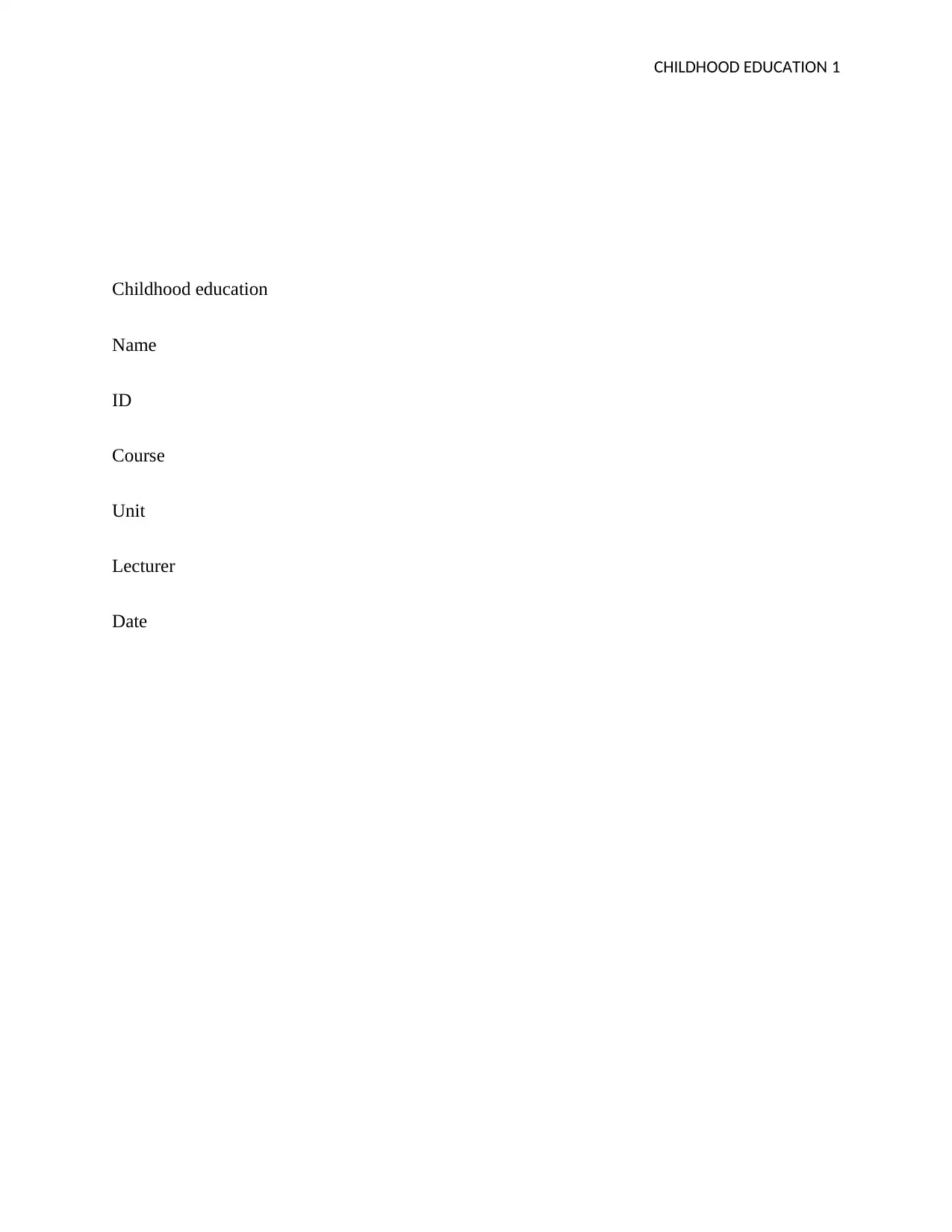
CHILDHOOD EDUCATION 1
Childhood education
Name
ID
Course
Unit
Lecturer
Date
Childhood education
Name
ID
Course
Unit
Lecturer
Date
Paraphrase This Document
Need a fresh take? Get an instant paraphrase of this document with our AI Paraphraser
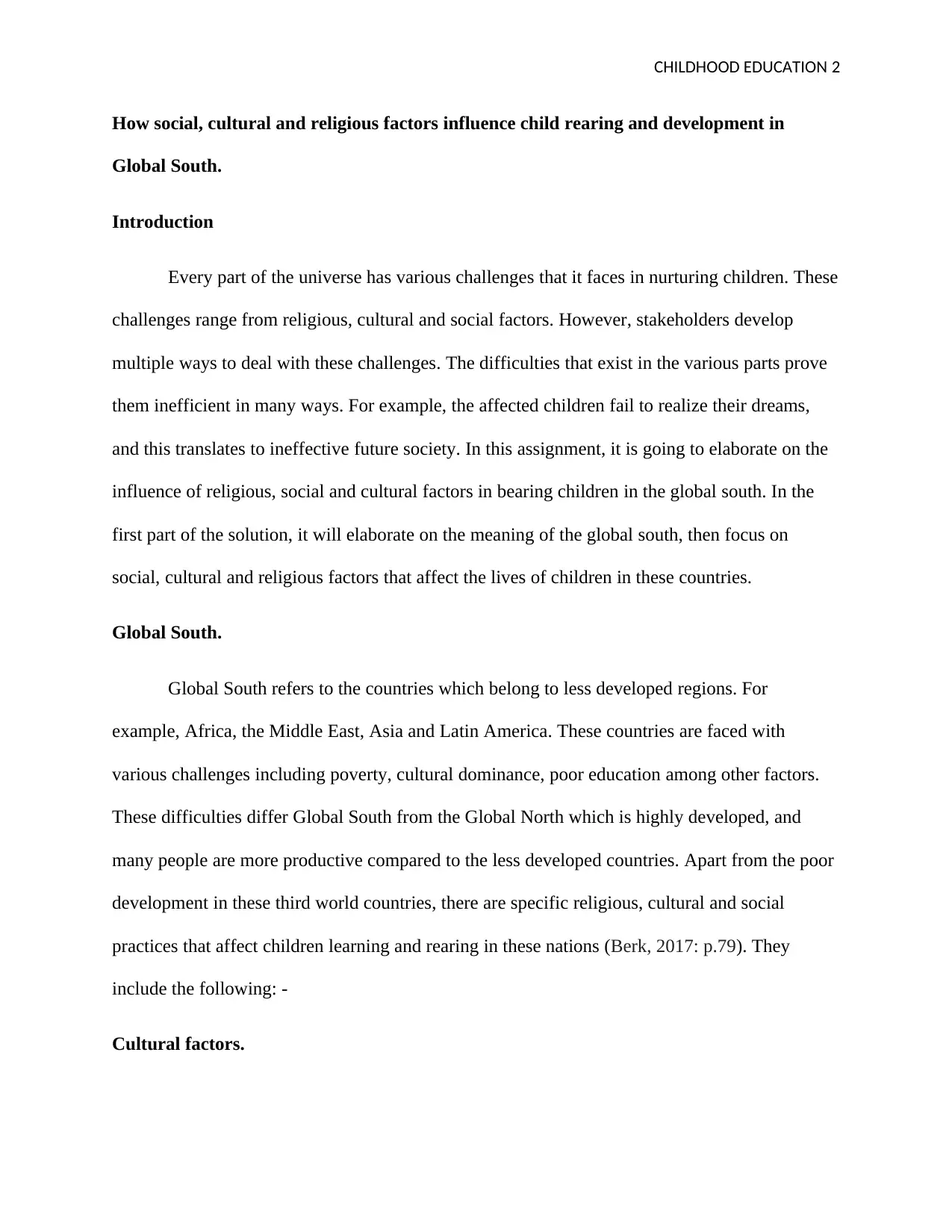
CHILDHOOD EDUCATION 2
How social, cultural and religious factors influence child rearing and development in
Global South.
Introduction
Every part of the universe has various challenges that it faces in nurturing children. These
challenges range from religious, cultural and social factors. However, stakeholders develop
multiple ways to deal with these challenges. The difficulties that exist in the various parts prove
them inefficient in many ways. For example, the affected children fail to realize their dreams,
and this translates to ineffective future society. In this assignment, it is going to elaborate on the
influence of religious, social and cultural factors in bearing children in the global south. In the
first part of the solution, it will elaborate on the meaning of the global south, then focus on
social, cultural and religious factors that affect the lives of children in these countries.
Global South.
Global South refers to the countries which belong to less developed regions. For
example, Africa, the Middle East, Asia and Latin America. These countries are faced with
various challenges including poverty, cultural dominance, poor education among other factors.
These difficulties differ Global South from the Global North which is highly developed, and
many people are more productive compared to the less developed countries. Apart from the poor
development in these third world countries, there are specific religious, cultural and social
practices that affect children learning and rearing in these nations (Berk, 2017: p.79). They
include the following: -
Cultural factors.
How social, cultural and religious factors influence child rearing and development in
Global South.
Introduction
Every part of the universe has various challenges that it faces in nurturing children. These
challenges range from religious, cultural and social factors. However, stakeholders develop
multiple ways to deal with these challenges. The difficulties that exist in the various parts prove
them inefficient in many ways. For example, the affected children fail to realize their dreams,
and this translates to ineffective future society. In this assignment, it is going to elaborate on the
influence of religious, social and cultural factors in bearing children in the global south. In the
first part of the solution, it will elaborate on the meaning of the global south, then focus on
social, cultural and religious factors that affect the lives of children in these countries.
Global South.
Global South refers to the countries which belong to less developed regions. For
example, Africa, the Middle East, Asia and Latin America. These countries are faced with
various challenges including poverty, cultural dominance, poor education among other factors.
These difficulties differ Global South from the Global North which is highly developed, and
many people are more productive compared to the less developed countries. Apart from the poor
development in these third world countries, there are specific religious, cultural and social
practices that affect children learning and rearing in these nations (Berk, 2017: p.79). They
include the following: -
Cultural factors.
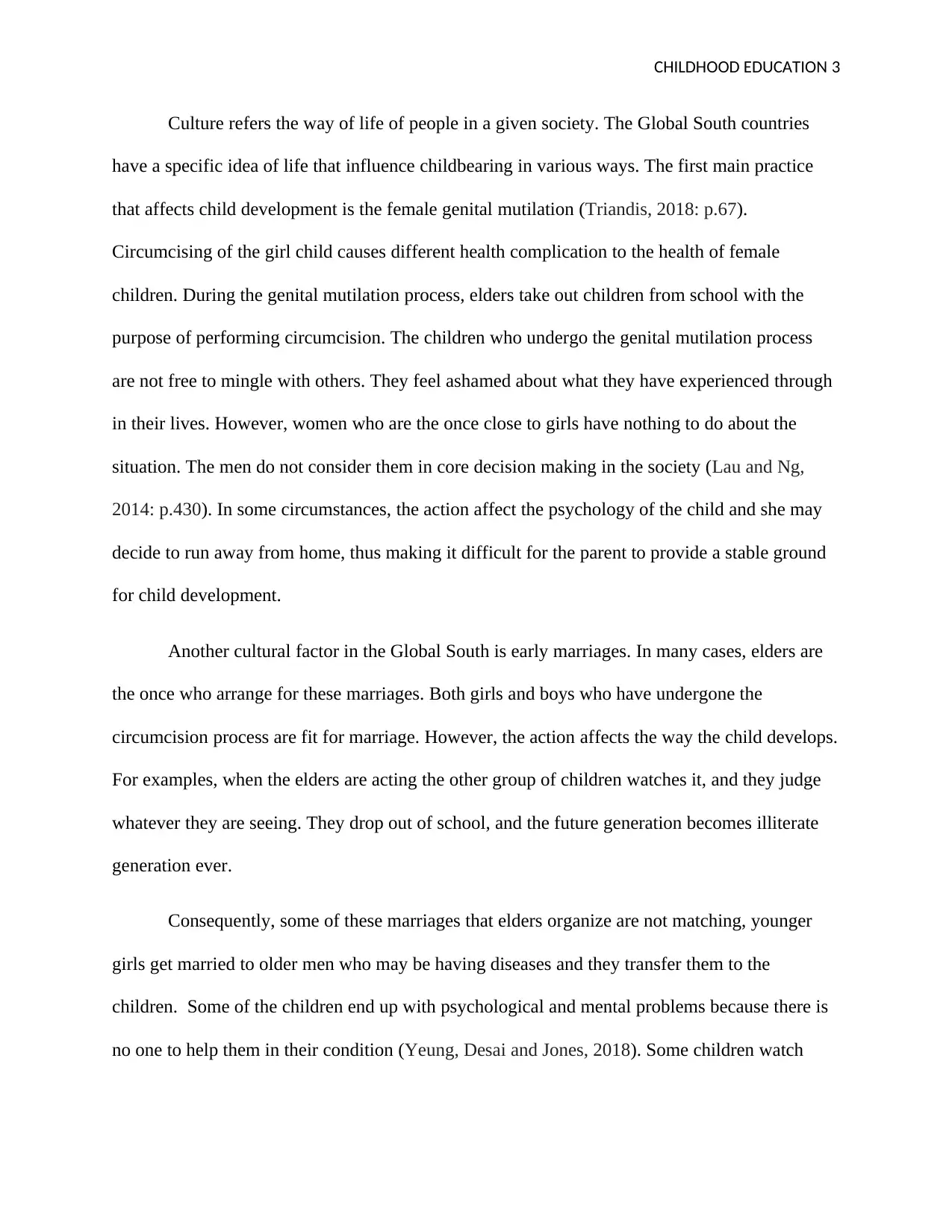
CHILDHOOD EDUCATION 3
Culture refers the way of life of people in a given society. The Global South countries
have a specific idea of life that influence childbearing in various ways. The first main practice
that affects child development is the female genital mutilation (Triandis, 2018: p.67).
Circumcising of the girl child causes different health complication to the health of female
children. During the genital mutilation process, elders take out children from school with the
purpose of performing circumcision. The children who undergo the genital mutilation process
are not free to mingle with others. They feel ashamed about what they have experienced through
in their lives. However, women who are the once close to girls have nothing to do about the
situation. The men do not consider them in core decision making in the society (Lau and Ng,
2014: p.430). In some circumstances, the action affect the psychology of the child and she may
decide to run away from home, thus making it difficult for the parent to provide a stable ground
for child development.
Another cultural factor in the Global South is early marriages. In many cases, elders are
the once who arrange for these marriages. Both girls and boys who have undergone the
circumcision process are fit for marriage. However, the action affects the way the child develops.
For examples, when the elders are acting the other group of children watches it, and they judge
whatever they are seeing. They drop out of school, and the future generation becomes illiterate
generation ever.
Consequently, some of these marriages that elders organize are not matching, younger
girls get married to older men who may be having diseases and they transfer them to the
children. Some of the children end up with psychological and mental problems because there is
no one to help them in their condition (Yeung, Desai and Jones, 2018). Some children watch
Culture refers the way of life of people in a given society. The Global South countries
have a specific idea of life that influence childbearing in various ways. The first main practice
that affects child development is the female genital mutilation (Triandis, 2018: p.67).
Circumcising of the girl child causes different health complication to the health of female
children. During the genital mutilation process, elders take out children from school with the
purpose of performing circumcision. The children who undergo the genital mutilation process
are not free to mingle with others. They feel ashamed about what they have experienced through
in their lives. However, women who are the once close to girls have nothing to do about the
situation. The men do not consider them in core decision making in the society (Lau and Ng,
2014: p.430). In some circumstances, the action affect the psychology of the child and she may
decide to run away from home, thus making it difficult for the parent to provide a stable ground
for child development.
Another cultural factor in the Global South is early marriages. In many cases, elders are
the once who arrange for these marriages. Both girls and boys who have undergone the
circumcision process are fit for marriage. However, the action affects the way the child develops.
For examples, when the elders are acting the other group of children watches it, and they judge
whatever they are seeing. They drop out of school, and the future generation becomes illiterate
generation ever.
Consequently, some of these marriages that elders organize are not matching, younger
girls get married to older men who may be having diseases and they transfer them to the
children. Some of the children end up with psychological and mental problems because there is
no one to help them in their condition (Yeung, Desai and Jones, 2018). Some children watch
⊘ This is a preview!⊘
Do you want full access?
Subscribe today to unlock all pages.

Trusted by 1+ million students worldwide
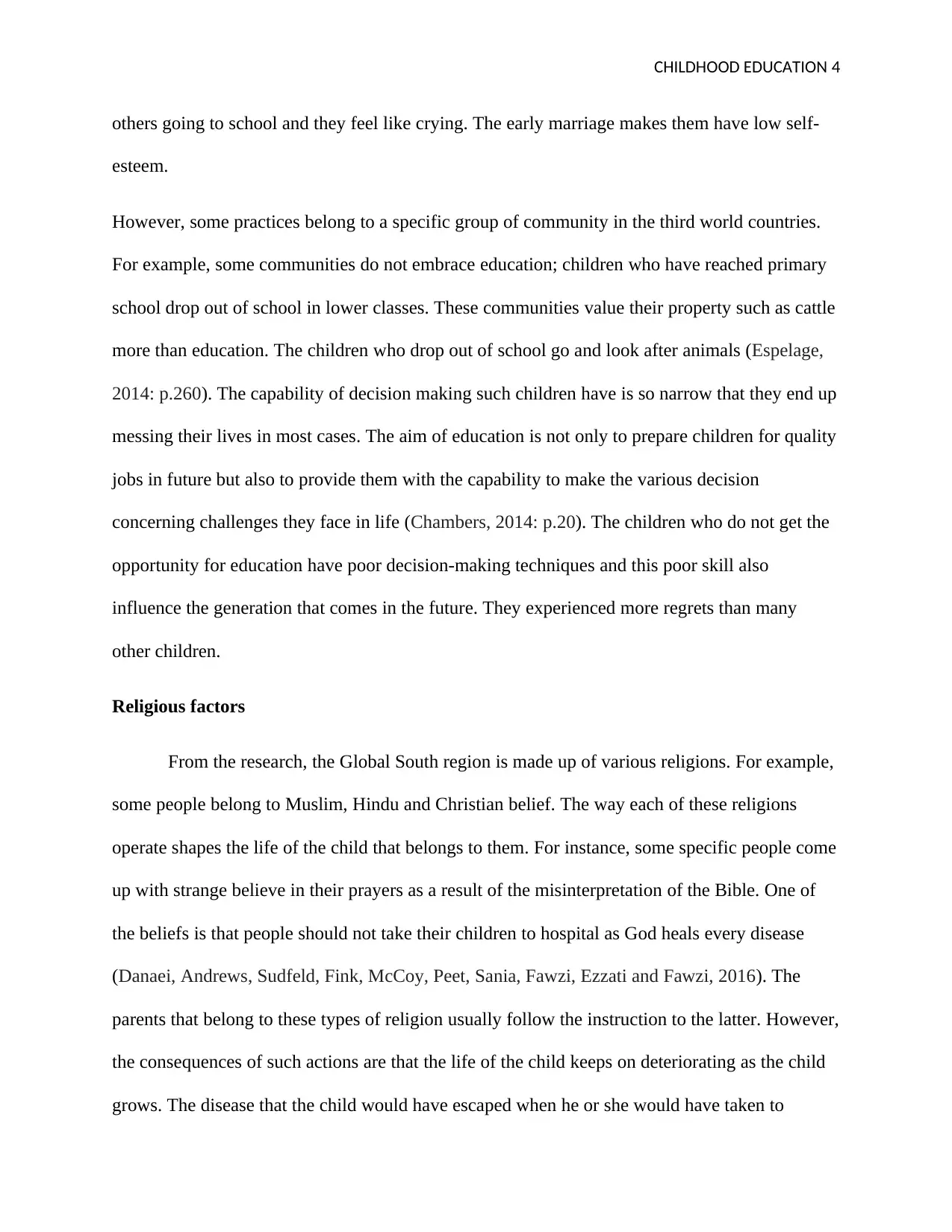
CHILDHOOD EDUCATION 4
others going to school and they feel like crying. The early marriage makes them have low self-
esteem.
However, some practices belong to a specific group of community in the third world countries.
For example, some communities do not embrace education; children who have reached primary
school drop out of school in lower classes. These communities value their property such as cattle
more than education. The children who drop out of school go and look after animals (Espelage,
2014: p.260). The capability of decision making such children have is so narrow that they end up
messing their lives in most cases. The aim of education is not only to prepare children for quality
jobs in future but also to provide them with the capability to make the various decision
concerning challenges they face in life (Chambers, 2014: p.20). The children who do not get the
opportunity for education have poor decision-making techniques and this poor skill also
influence the generation that comes in the future. They experienced more regrets than many
other children.
Religious factors
From the research, the Global South region is made up of various religions. For example,
some people belong to Muslim, Hindu and Christian belief. The way each of these religions
operate shapes the life of the child that belongs to them. For instance, some specific people come
up with strange believe in their prayers as a result of the misinterpretation of the Bible. One of
the beliefs is that people should not take their children to hospital as God heals every disease
(Danaei, Andrews, Sudfeld, Fink, McCoy, Peet, Sania, Fawzi, Ezzati and Fawzi, 2016). The
parents that belong to these types of religion usually follow the instruction to the latter. However,
the consequences of such actions are that the life of the child keeps on deteriorating as the child
grows. The disease that the child would have escaped when he or she would have taken to
others going to school and they feel like crying. The early marriage makes them have low self-
esteem.
However, some practices belong to a specific group of community in the third world countries.
For example, some communities do not embrace education; children who have reached primary
school drop out of school in lower classes. These communities value their property such as cattle
more than education. The children who drop out of school go and look after animals (Espelage,
2014: p.260). The capability of decision making such children have is so narrow that they end up
messing their lives in most cases. The aim of education is not only to prepare children for quality
jobs in future but also to provide them with the capability to make the various decision
concerning challenges they face in life (Chambers, 2014: p.20). The children who do not get the
opportunity for education have poor decision-making techniques and this poor skill also
influence the generation that comes in the future. They experienced more regrets than many
other children.
Religious factors
From the research, the Global South region is made up of various religions. For example,
some people belong to Muslim, Hindu and Christian belief. The way each of these religions
operate shapes the life of the child that belongs to them. For instance, some specific people come
up with strange believe in their prayers as a result of the misinterpretation of the Bible. One of
the beliefs is that people should not take their children to hospital as God heals every disease
(Danaei, Andrews, Sudfeld, Fink, McCoy, Peet, Sania, Fawzi, Ezzati and Fawzi, 2016). The
parents that belong to these types of religion usually follow the instruction to the latter. However,
the consequences of such actions are that the life of the child keeps on deteriorating as the child
grows. The disease that the child would have escaped when he or she would have taken to
Paraphrase This Document
Need a fresh take? Get an instant paraphrase of this document with our AI Paraphraser
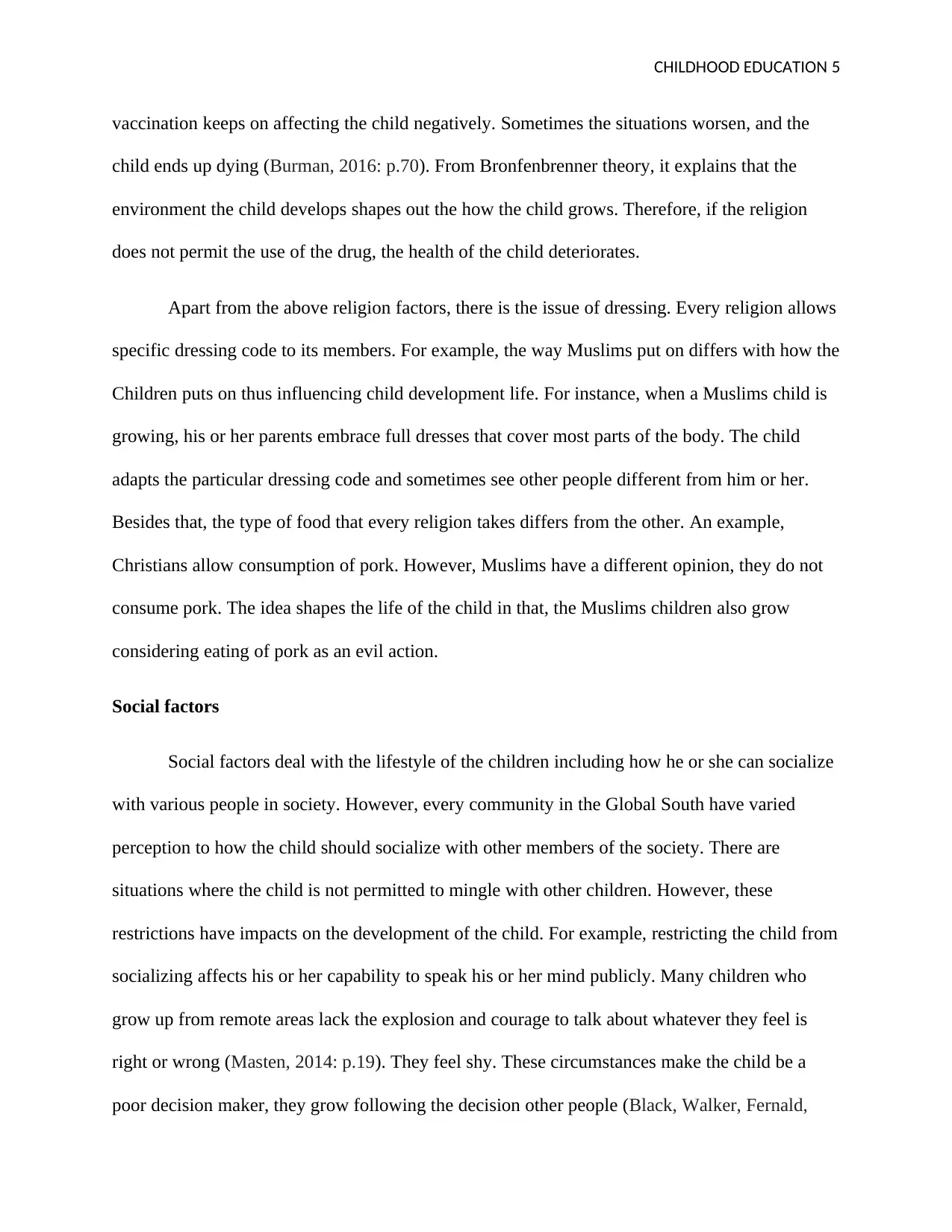
CHILDHOOD EDUCATION 5
vaccination keeps on affecting the child negatively. Sometimes the situations worsen, and the
child ends up dying (Burman, 2016: p.70). From Bronfenbrenner theory, it explains that the
environment the child develops shapes out the how the child grows. Therefore, if the religion
does not permit the use of the drug, the health of the child deteriorates.
Apart from the above religion factors, there is the issue of dressing. Every religion allows
specific dressing code to its members. For example, the way Muslims put on differs with how the
Children puts on thus influencing child development life. For instance, when a Muslims child is
growing, his or her parents embrace full dresses that cover most parts of the body. The child
adapts the particular dressing code and sometimes see other people different from him or her.
Besides that, the type of food that every religion takes differs from the other. An example,
Christians allow consumption of pork. However, Muslims have a different opinion, they do not
consume pork. The idea shapes the life of the child in that, the Muslims children also grow
considering eating of pork as an evil action.
Social factors
Social factors deal with the lifestyle of the children including how he or she can socialize
with various people in society. However, every community in the Global South have varied
perception to how the child should socialize with other members of the society. There are
situations where the child is not permitted to mingle with other children. However, these
restrictions have impacts on the development of the child. For example, restricting the child from
socializing affects his or her capability to speak his or her mind publicly. Many children who
grow up from remote areas lack the explosion and courage to talk about whatever they feel is
right or wrong (Masten, 2014: p.19). They feel shy. These circumstances make the child be a
poor decision maker, they grow following the decision other people (Black, Walker, Fernald,
vaccination keeps on affecting the child negatively. Sometimes the situations worsen, and the
child ends up dying (Burman, 2016: p.70). From Bronfenbrenner theory, it explains that the
environment the child develops shapes out the how the child grows. Therefore, if the religion
does not permit the use of the drug, the health of the child deteriorates.
Apart from the above religion factors, there is the issue of dressing. Every religion allows
specific dressing code to its members. For example, the way Muslims put on differs with how the
Children puts on thus influencing child development life. For instance, when a Muslims child is
growing, his or her parents embrace full dresses that cover most parts of the body. The child
adapts the particular dressing code and sometimes see other people different from him or her.
Besides that, the type of food that every religion takes differs from the other. An example,
Christians allow consumption of pork. However, Muslims have a different opinion, they do not
consume pork. The idea shapes the life of the child in that, the Muslims children also grow
considering eating of pork as an evil action.
Social factors
Social factors deal with the lifestyle of the children including how he or she can socialize
with various people in society. However, every community in the Global South have varied
perception to how the child should socialize with other members of the society. There are
situations where the child is not permitted to mingle with other children. However, these
restrictions have impacts on the development of the child. For example, restricting the child from
socializing affects his or her capability to speak his or her mind publicly. Many children who
grow up from remote areas lack the explosion and courage to talk about whatever they feel is
right or wrong (Masten, 2014: p.19). They feel shy. These circumstances make the child be a
poor decision maker, they grow following the decision other people (Black, Walker, Fernald,
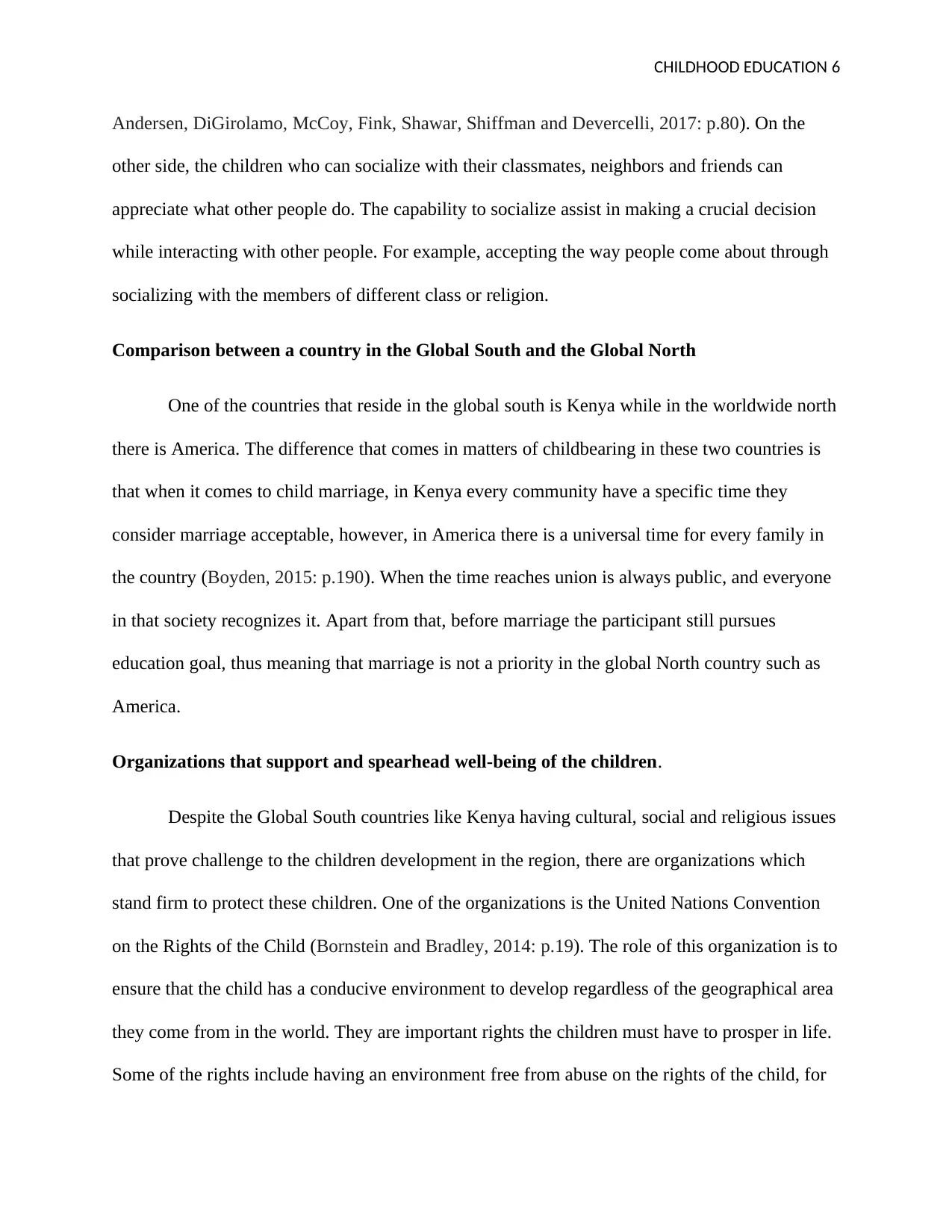
CHILDHOOD EDUCATION 6
Andersen, DiGirolamo, McCoy, Fink, Shawar, Shiffman and Devercelli, 2017: p.80). On the
other side, the children who can socialize with their classmates, neighbors and friends can
appreciate what other people do. The capability to socialize assist in making a crucial decision
while interacting with other people. For example, accepting the way people come about through
socializing with the members of different class or religion.
Comparison between a country in the Global South and the Global North
One of the countries that reside in the global south is Kenya while in the worldwide north
there is America. The difference that comes in matters of childbearing in these two countries is
that when it comes to child marriage, in Kenya every community have a specific time they
consider marriage acceptable, however, in America there is a universal time for every family in
the country (Boyden, 2015: p.190). When the time reaches union is always public, and everyone
in that society recognizes it. Apart from that, before marriage the participant still pursues
education goal, thus meaning that marriage is not a priority in the global North country such as
America.
Organizations that support and spearhead well-being of the children.
Despite the Global South countries like Kenya having cultural, social and religious issues
that prove challenge to the children development in the region, there are organizations which
stand firm to protect these children. One of the organizations is the United Nations Convention
on the Rights of the Child (Bornstein and Bradley, 2014: p.19). The role of this organization is to
ensure that the child has a conducive environment to develop regardless of the geographical area
they come from in the world. They are important rights the children must have to prosper in life.
Some of the rights include having an environment free from abuse on the rights of the child, for
Andersen, DiGirolamo, McCoy, Fink, Shawar, Shiffman and Devercelli, 2017: p.80). On the
other side, the children who can socialize with their classmates, neighbors and friends can
appreciate what other people do. The capability to socialize assist in making a crucial decision
while interacting with other people. For example, accepting the way people come about through
socializing with the members of different class or religion.
Comparison between a country in the Global South and the Global North
One of the countries that reside in the global south is Kenya while in the worldwide north
there is America. The difference that comes in matters of childbearing in these two countries is
that when it comes to child marriage, in Kenya every community have a specific time they
consider marriage acceptable, however, in America there is a universal time for every family in
the country (Boyden, 2015: p.190). When the time reaches union is always public, and everyone
in that society recognizes it. Apart from that, before marriage the participant still pursues
education goal, thus meaning that marriage is not a priority in the global North country such as
America.
Organizations that support and spearhead well-being of the children.
Despite the Global South countries like Kenya having cultural, social and religious issues
that prove challenge to the children development in the region, there are organizations which
stand firm to protect these children. One of the organizations is the United Nations Convention
on the Rights of the Child (Bornstein and Bradley, 2014: p.19). The role of this organization is to
ensure that the child has a conducive environment to develop regardless of the geographical area
they come from in the world. They are important rights the children must have to prosper in life.
Some of the rights include having an environment free from abuse on the rights of the child, for
⊘ This is a preview!⊘
Do you want full access?
Subscribe today to unlock all pages.

Trusted by 1+ million students worldwide
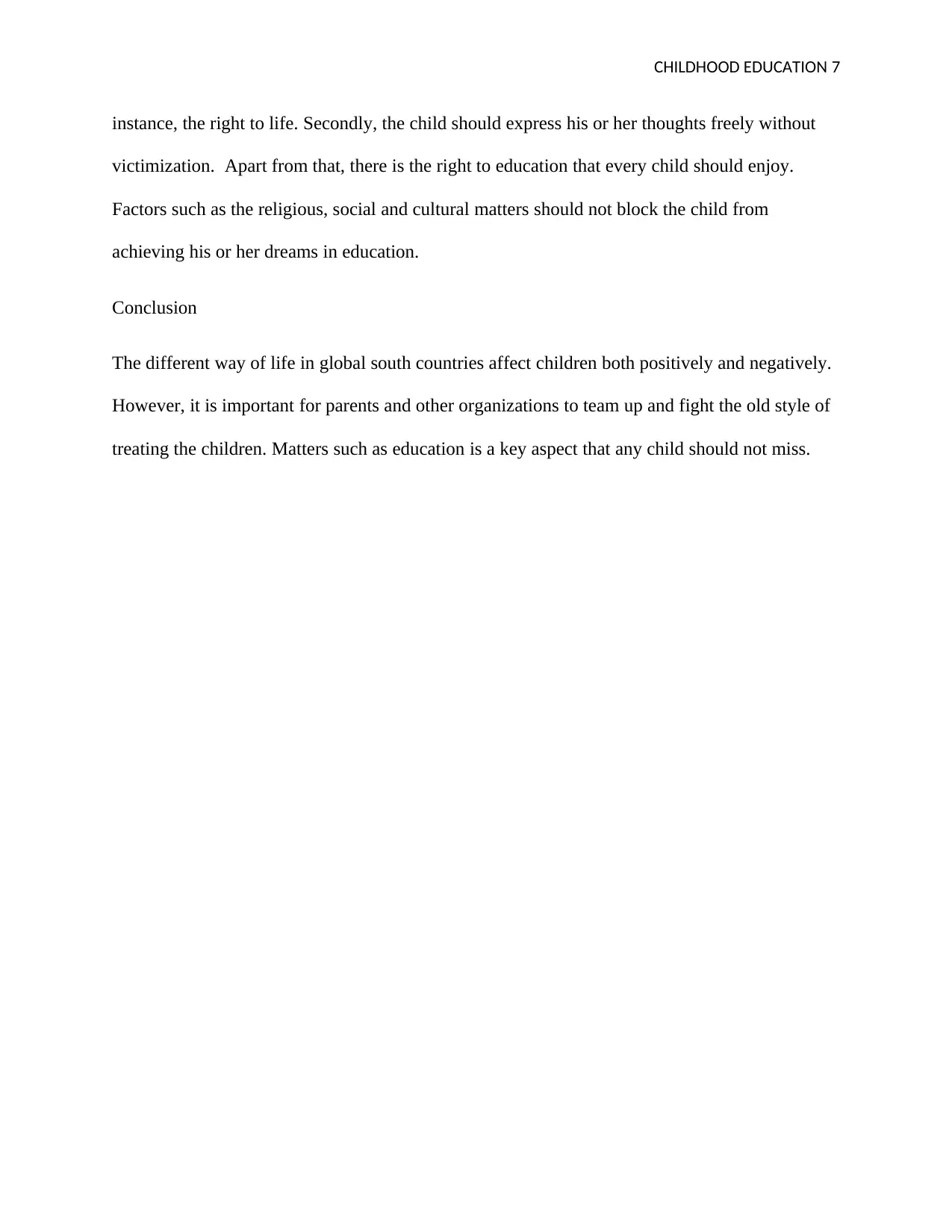
CHILDHOOD EDUCATION 7
instance, the right to life. Secondly, the child should express his or her thoughts freely without
victimization. Apart from that, there is the right to education that every child should enjoy.
Factors such as the religious, social and cultural matters should not block the child from
achieving his or her dreams in education.
Conclusion
The different way of life in global south countries affect children both positively and negatively.
However, it is important for parents and other organizations to team up and fight the old style of
treating the children. Matters such as education is a key aspect that any child should not miss.
instance, the right to life. Secondly, the child should express his or her thoughts freely without
victimization. Apart from that, there is the right to education that every child should enjoy.
Factors such as the religious, social and cultural matters should not block the child from
achieving his or her dreams in education.
Conclusion
The different way of life in global south countries affect children both positively and negatively.
However, it is important for parents and other organizations to team up and fight the old style of
treating the children. Matters such as education is a key aspect that any child should not miss.
Paraphrase This Document
Need a fresh take? Get an instant paraphrase of this document with our AI Paraphraser
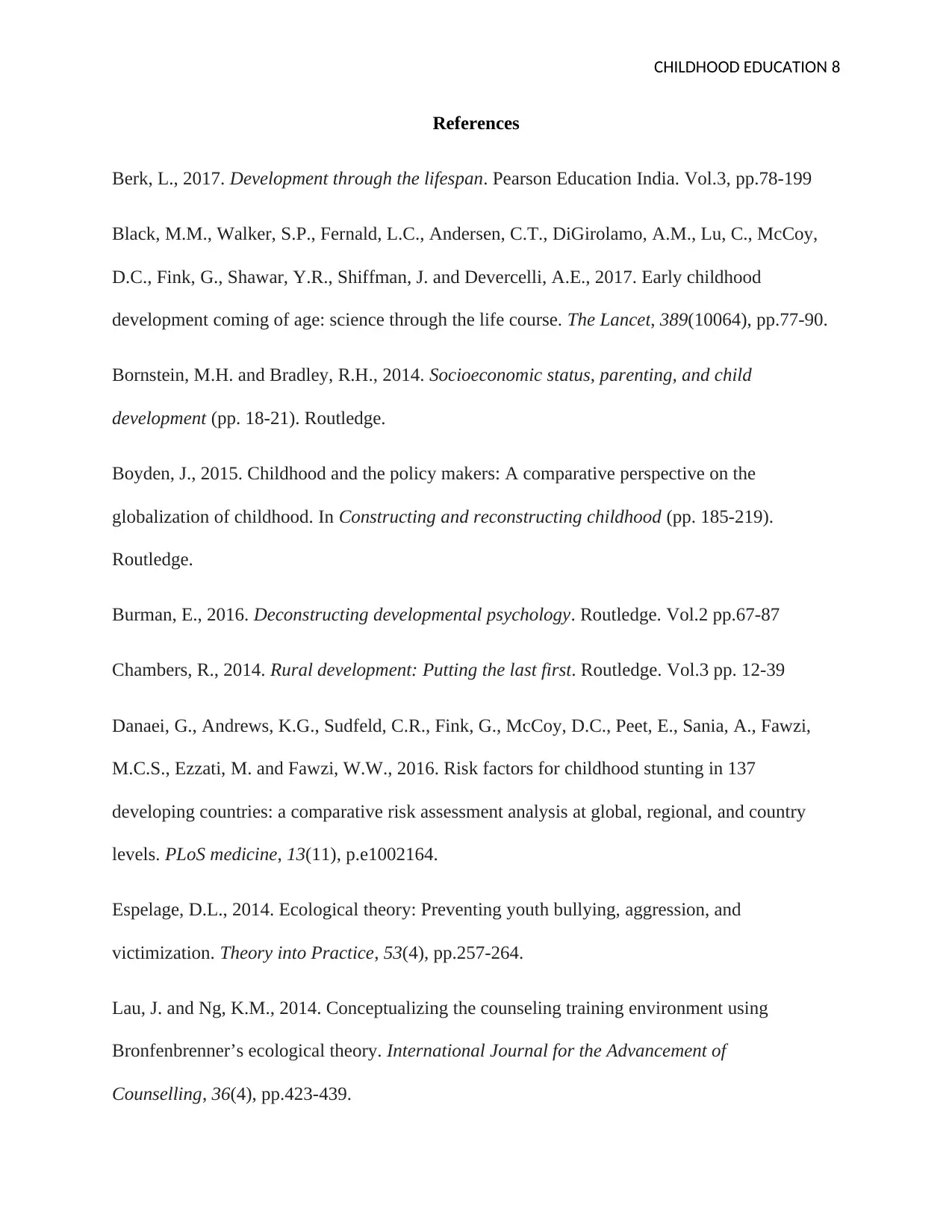
CHILDHOOD EDUCATION 8
References
Berk, L., 2017. Development through the lifespan. Pearson Education India. Vol.3, pp.78-199
Black, M.M., Walker, S.P., Fernald, L.C., Andersen, C.T., DiGirolamo, A.M., Lu, C., McCoy,
D.C., Fink, G., Shawar, Y.R., Shiffman, J. and Devercelli, A.E., 2017. Early childhood
development coming of age: science through the life course. The Lancet, 389(10064), pp.77-90.
Bornstein, M.H. and Bradley, R.H., 2014. Socioeconomic status, parenting, and child
development (pp. 18-21). Routledge.
Boyden, J., 2015. Childhood and the policy makers: A comparative perspective on the
globalization of childhood. In Constructing and reconstructing childhood (pp. 185-219).
Routledge.
Burman, E., 2016. Deconstructing developmental psychology. Routledge. Vol.2 pp.67-87
Chambers, R., 2014. Rural development: Putting the last first. Routledge. Vol.3 pp. 12-39
Danaei, G., Andrews, K.G., Sudfeld, C.R., Fink, G., McCoy, D.C., Peet, E., Sania, A., Fawzi,
M.C.S., Ezzati, M. and Fawzi, W.W., 2016. Risk factors for childhood stunting in 137
developing countries: a comparative risk assessment analysis at global, regional, and country
levels. PLoS medicine, 13(11), p.e1002164.
Espelage, D.L., 2014. Ecological theory: Preventing youth bullying, aggression, and
victimization. Theory into Practice, 53(4), pp.257-264.
Lau, J. and Ng, K.M., 2014. Conceptualizing the counseling training environment using
Bronfenbrenner’s ecological theory. International Journal for the Advancement of
Counselling, 36(4), pp.423-439.
References
Berk, L., 2017. Development through the lifespan. Pearson Education India. Vol.3, pp.78-199
Black, M.M., Walker, S.P., Fernald, L.C., Andersen, C.T., DiGirolamo, A.M., Lu, C., McCoy,
D.C., Fink, G., Shawar, Y.R., Shiffman, J. and Devercelli, A.E., 2017. Early childhood
development coming of age: science through the life course. The Lancet, 389(10064), pp.77-90.
Bornstein, M.H. and Bradley, R.H., 2014. Socioeconomic status, parenting, and child
development (pp. 18-21). Routledge.
Boyden, J., 2015. Childhood and the policy makers: A comparative perspective on the
globalization of childhood. In Constructing and reconstructing childhood (pp. 185-219).
Routledge.
Burman, E., 2016. Deconstructing developmental psychology. Routledge. Vol.2 pp.67-87
Chambers, R., 2014. Rural development: Putting the last first. Routledge. Vol.3 pp. 12-39
Danaei, G., Andrews, K.G., Sudfeld, C.R., Fink, G., McCoy, D.C., Peet, E., Sania, A., Fawzi,
M.C.S., Ezzati, M. and Fawzi, W.W., 2016. Risk factors for childhood stunting in 137
developing countries: a comparative risk assessment analysis at global, regional, and country
levels. PLoS medicine, 13(11), p.e1002164.
Espelage, D.L., 2014. Ecological theory: Preventing youth bullying, aggression, and
victimization. Theory into Practice, 53(4), pp.257-264.
Lau, J. and Ng, K.M., 2014. Conceptualizing the counseling training environment using
Bronfenbrenner’s ecological theory. International Journal for the Advancement of
Counselling, 36(4), pp.423-439.
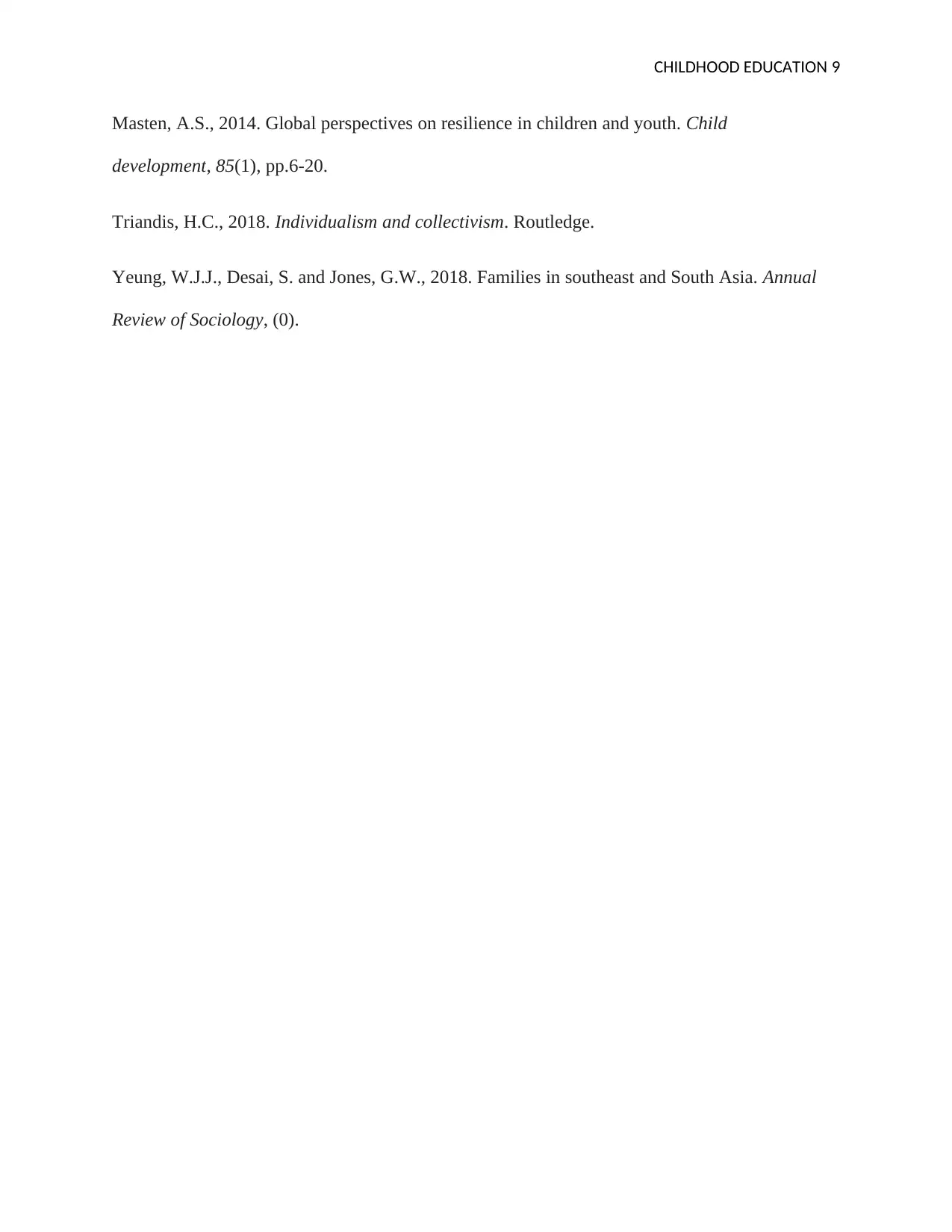
CHILDHOOD EDUCATION 9
Masten, A.S., 2014. Global perspectives on resilience in children and youth. Child
development, 85(1), pp.6-20.
Triandis, H.C., 2018. Individualism and collectivism. Routledge.
Yeung, W.J.J., Desai, S. and Jones, G.W., 2018. Families in southeast and South Asia. Annual
Review of Sociology, (0).
Masten, A.S., 2014. Global perspectives on resilience in children and youth. Child
development, 85(1), pp.6-20.
Triandis, H.C., 2018. Individualism and collectivism. Routledge.
Yeung, W.J.J., Desai, S. and Jones, G.W., 2018. Families in southeast and South Asia. Annual
Review of Sociology, (0).
⊘ This is a preview!⊘
Do you want full access?
Subscribe today to unlock all pages.

Trusted by 1+ million students worldwide
1 out of 9
Related Documents
Your All-in-One AI-Powered Toolkit for Academic Success.
+13062052269
info@desklib.com
Available 24*7 on WhatsApp / Email
![[object Object]](/_next/static/media/star-bottom.7253800d.svg)
Unlock your academic potential
Copyright © 2020–2025 A2Z Services. All Rights Reserved. Developed and managed by ZUCOL.




